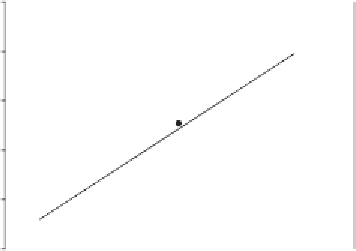Agriculture Reference
In-Depth Information
effective using CID when assessment is made on
single plots. This is because large genotype ×
environment interaction and residual variances
reduce narrow-sense heritability for yield and
biomass in nonreplicated plots. The relative
benefi t of correlated genetic gain is reduced with
replicated testing over blocks and environments,
which increases heritability for yield but less so
for biomass. Notwithstanding, CID offers poten-
tial for screening nonreplicated families in the
early stages of yield testing, such as occurs when
little seed is available or while early generations
are still genetically heterogeneous. By selecting
families with low CID, the breeder is restricting
the costly stages of replicated yield testing across
environments to those families with a greater like-
lihood of high yield in water-limited environ-
ments (e.g., in the release of the high water-use
effi ciency wheat cultivars from Australia, 'Drys-
dale' and 'Rees'). Further, by fi xing favorable
alleles for CID, greater emphasis can be placed on
selection for other genes important for adaptation
to water-limited environments.
Finally, it must be well established that indirect
selection produces a correlated change in the
desired trait in the TPE. Thus the value of traits
conferring specifi c adaptation (e.g., CID vs. seed-
ling vigor and their effects on water use; Condon
et al., 2004) must be recognized with selection for
the target environment type and their frequency
in the TPE.
intergenotypic competition between adjacent
plots, while breeders are careful in selecting
uniform sites and/or mapping fi eld variability for
known soil constraints (e.g., micronutrients or
salinity).
There is substantial genetic diversity in wheat
and its relatives, but adoption may be limited by
repulsion-phase linkages with detrimental genes
(e.g.,
Cre1
and pinched grain), thereby slowing
adoption and making assessment of new diversity
a potentially expensive undertaking. Further-
more, genetically and physiologically complex
traits such as water-soluble carbohydrate (WSC)
concentration, or traits expensive to measure such
as CID, may limit their adoption and subsequent
selection in breeding programs despite their value
in breeding. New tools are becoming increasingly
available for phenotyping and selection of complex
traits by breeders in early and later stages of
family evaluation. Spectral information obtained
through near-infrared (NIR) spectroscopy is
inexpensive and reliable with potential as a sur-
rogate for leaf nitrogen, CID, and WSC concen-
tration (Ruuska et al., 2006). For example,
Fig. 11.5 shows predicted versus actual WSC
concentrations for wheat genotypes grown at
different plant densities using a general NIR
300
Westonia
250
High-throughput phenotyping
The dynamic nature of rainfed, water-limited
environments makes selection for improved grain
yield a challenge to wheat breeders. Improved
understanding of genotype × environment
interaction and subsequent characterization of
environment types, coupled with improved
experimental designs (Singh et al., 2003) and sta-
tistical methodology (Smith et al., 2001), have
contributed to reduced error variances to increase
heritability and response to selection for yield.
Similarly, improved experimental techniques are
being employed to reduce experimental error in
measuring yield. For example, removal of border
rows at maturity will reduce the effects of
200
Janz
150
100
50
100
150
200
250
300
350
Actual WSC concentration (mg/g DW)
Fig. 11.5
Water-soluble carbohydrate (WSC) concentration
measured for 22 wheat genotypes sown at 5 densities plotted
against predicted WSC concentration using a NIR calibration
equation developed for a wheat mapping population evalu-
ated in southern Australia. High ('Westonia') and intermedi-
ate ('Janz') WSC concentration genotypes are shown for
comparison (Y
=
−
35
+
0.92X,
r
2
=
0.93).



























































































































































































